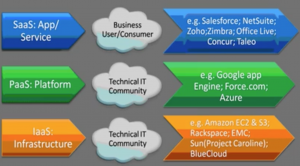What is Cloud Computing ?
Cloud computing is a concept which is Network based computing that provides shared computer processing resources and data to computers and other devices and the Network in Internet.
Cloud Computing Definition
Cloud Computing separates application from it’s Hardware and Software dependencies. To understand What is Cloud Computing clearly let us discuss the topic with simple example.
The term “cloud computing” and “working in the cloud” refer to performing computer tasks using services delivered entirely over the internet.
Cloud Computing Introduction
It is very important to understand about Cloud Computing and its evolutionary process. From the first generation of Computers to Fourth generation of Computers hardware improvements, Software technologies, Networking techniques have been developed and lead to rapid growth in Internet Usage. Due to vast change in Technologies today we are using Internet Protocol version 6(IPv6). Let us discuss some of the issues of Cloud Computing and its Computational Technology in a historical context.
How hardware Evolution Started
- The first step in hardware Evolution Started in 1930 by developing Binary Arithmetic. Using Binary Arithmetic many computer processing technologies, terminology and programming languages has been developed.
- In 1939, Berry brothers invented electronic computer which can be operated digitally and computations were performed using vacuum-tube technology.
- IN 1941, Konard Zuse’s Z3 was introduced. This Z3 supports floating point and binary arithmetic.
- In 1943, First generation computers were developed.
- In 1946, Second generation computers ENIAC (Electronic Numerical Integrator and Computer) was built by U.S Army’s ballistic Research Laboratory.
- In Early 1950s and 1960 transistorised computers came into existence.
- In 1958, Kilby invented third generation computers.
- In November 1971, Intel released the world’s first commercial microprocessor.
- Using Microprocessor, Fourth generation computers were developed.
- Intel developed RAM(Random Access Memory).
- In 1974, first commercial personal computer MITS Altair 8800 released.
- In Mid-1980 PC era has begun.
Relationship between Cloud Computing & Salesforce
Here we are to learn about What is Cloud Computing. Before learning about Cloud computing we have to understand what is the relationship between Cloud Computing and Salesforce.com. As there are so many CRM Softwares are available in the market but why Salesforce.com is emerged world’s #1 on demand CRM.
Considering People Soft CRM it came to market in Early 1980’s and Siebel CMR it came to market in early 1990’s. These Two CRM’s are more efficient CRM and have many happy customers but why there is a transition from other CRM’s to Salesforce CRM. The main differentiating feature from other CRM’s to Salesforce CRM is Cloud Computing.
Salesforce is the worlds #1 on Demand on Cloud CRM that based on Cloud Computing. It’s on Cloud CRM. Now we understand that Salesforce CRM is based on Cloud Computing so what is Cloud Computing? what is the term Cloud Computing mean?
Example : Gmail is the best example for cloud computing. If we want to send an email simply we log on to gmail.com and send an Email. Do we require any Software and Hardware dependencies to send Email from Gmail.com. Here the application(Gmail.com) is separated from Hardware and Software dependencies. The same way Salesforce.com works. In Salesforce.com, we have to create an account and start using Salesforce.com CRM.
Hardware and Software dependencies like servers and databases are maintained by Cloud Computing Vendors.
Cloud Computing Features
- It is Network based computing.
- We require computer with internet connection and a browser.
- It is a on cloud application.
- It is on demand application.
- It has shares resources.
- Internet based development and Services.
- Just pay for what you use.
- It is Multi-tenant architecture.
- Automatic Upgrades.
- It is highly Secure.
Different Cloud Computing Models
In Cloud Computing we have three models they are
- SaaS (Software as a Service).
- PaaS (Platform as a Service).
- IaaS (Infrastructure as a Service).

SaaS (Software as a Service)
In Software as a Service model, Softwares are distributed over the cloud. No need to install software and no physical infrastructure is required. The final product or application is available in this service.
Examples of SaaS cloud providers.
- Salesforce.
- NetSuite.
- Zoho.
- Zimbra.
- Office Live.
- Concur.
- Taleo.
PaaS (Platform as a Service)
In Platform as a Service, the cloud service providers will provide Hardware, Storage, Network services over the cloud. Here the application is not available as a service but they provide platform to develop our application.
Examples of PaaS cloud providers.
- Google App Engine.
- Force.com.
- Azure.
IaaS (Infrastructure as a Service)
In Infrastructure as a Service model, the cloud service providers will provide infrastructure like Servers, hosting services. Here we don’t have any final product or a platform to develop application, here we have a space to setup platform and then we have to build the application and use it.
Examples of IaaS cloud providers.
- Amazon EC2 and S3.
- Rackspace.
- EMC.
- Sun(project Caroline).
- BlueCloud.
